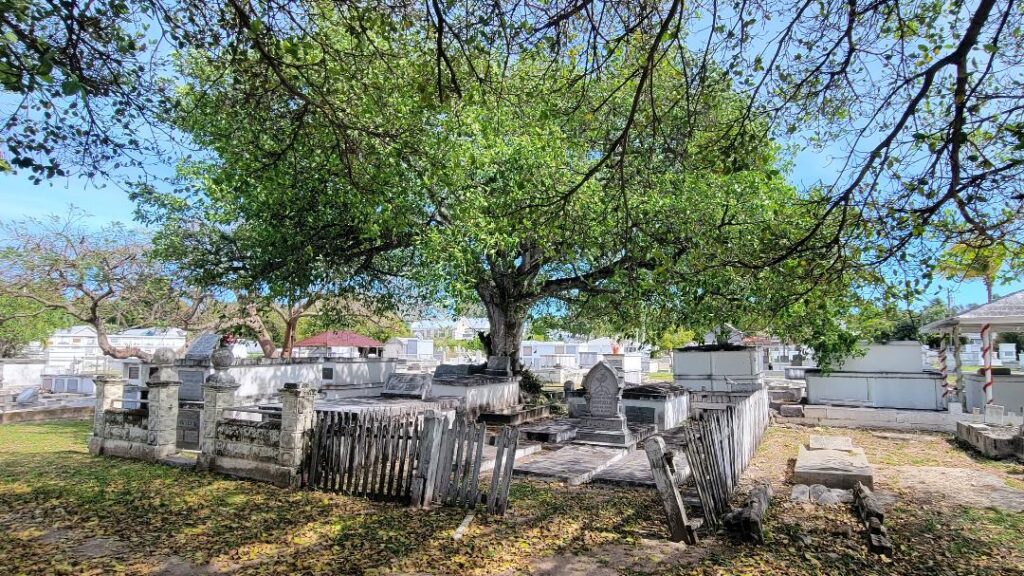
Older cities around the Western world pride themselves with their history, legends, and traditions. Some of the legends include stories of ghosts. The tourism industry capitalizes on the local ghosts by offering city specific ghost tours, pulling the old and the young alike. I recently went on a ghost tour in Key West where I learned about Manuel Cabeza, a World War I veteran who settled in Key West and was in a relationship with a woman of mixed race. This relationship provoked local Ku Klux Klan, who beat Manuel and tarred and feathered him. During the struggle, one of the Ku Klux Klan’s white head coverings slipped off and the man’s face was recognized by Manuel. The face was that of William Decker, manager of a local cigar factory. The next day Manuel met William on Duval Street and shot him. Manuel Cabeza was arrested and placed in the Key West jail. One night all the jailers left the premises unguarded and fifteen men broke in, dragged Manual Cabeza out lynched and shot him. His body was dragged through the streets of Key West and hung on a palm tree. In 1921 the population of Key West was about 20,000; our tour guide said at that time everyone knew everyone else’s business and very few incidents went unnoticed. And yet peculiarly, no one knew anything about what happened to Manuel or who did these awful things. As the story goes, Manuel’s girlfriend used an ancient voodoo spell on the perpetrators and left Key West. Consequently, the men who killed Manuel all died within a few years in various mysterious circumstances. Manuel Cabeza was buried in the Key West cemetery. Many years later, the city repented and Manuel received a proper burial as a war hero. The burial was attended by Key West city officials, representatives of US Armed Forces and his 99-year-old niece. Today, the grave is marked as number 34 in the Self Guide to the Key West Cemetery brochure. Manuel’s story motivated me to visit the Key West cemetery.

I entered the cemetery through the main gate next to the Sexton’s Office. Not knowing that there were Self Guide brochures available, I walked down the Palm Avenue and aimlessly wandered around. It was about two o’clock on a mid-March Saturday. The sun was high in the sky, burning the ground with its rays. The air was still at 85 degrees but felt like a 100. Heat was beaming off the paved avenues and off the numerous gravestones. There was little shade available and everything looked bright burning the retinas of my eyes. Looking around there was a vast emptiness of humanity. On a rare occasion, I could see a single bicyclist cycling through one of the numerous avenues, probably a local taking a short cut on the way home or going to work. Once they zoomed by it was only me and the dead resting in stone boxes in various stages of disrepair. It was weird to see graves crumbling. If the stones are crumbling, the bones within must have already turned to dust and the dust already mixed with earth leaving nothing noticeable within the dark cavity underneath.
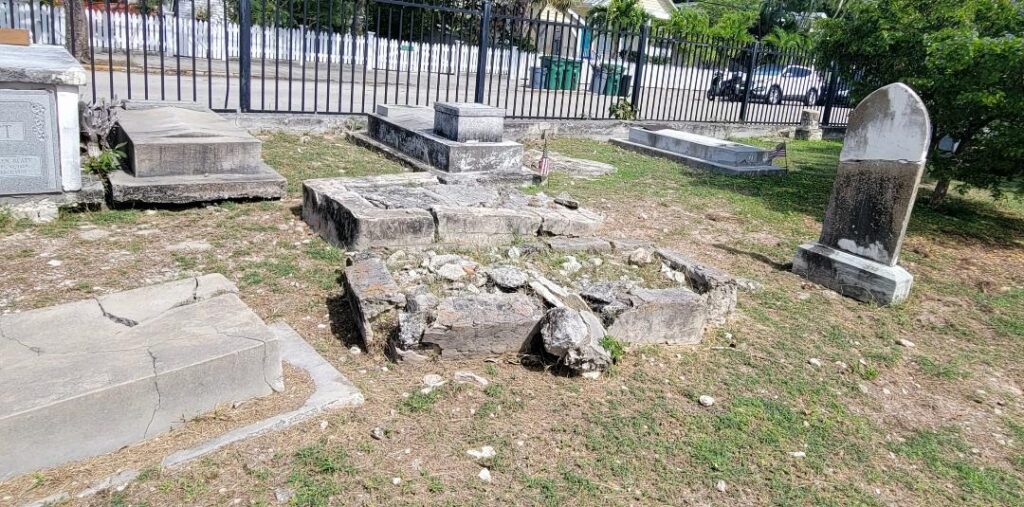
Walking around, I realized in addition to the main cemetery there were two other separate fenced off areas. One marked as a Catholic cemetery and the other marked as a Jewish cemetery. I found it peculiar that even in death, we the people have a need to separate ourselves from those we consider unlike us. Apparently we differentiate skeletons, we differentiate ashes, and for whatever reason one set of bones is different than the other and not all ashes were created equal, a peculiar concept.

As I walked around I tried to figure out an order or chronology to the burial system but I was not able to distinguish time-based organization. The architecture appeared in a disarray with old and new all mixed together. Many of the graves had a mid-nineteenth century date on the headstones. During the eighteen hundreds Key West experienced its glory as the wealthiest city per capita in the United States, due to the proximity of a shallow ocean reef and the resulting ship-wreck industry that flourished. I kept wandering around the avenues. Graveyards even when engulfed in a mid-day sun and hugged by shabby palm leaves are nevertheless sober and spooky. Walking around reading names, I was acutely aware that these people once full of live are now dead. Judging by deteriorating masonry on many graves, a link in the generational chain has been broken and no kin remains to remember them. The congruity of their burial place has been disturbed and no one cares.
Headstone engravings had a variety of messages, some simply informational with names and dates relevant to the bones resting underneath. Others were lighthearted: I am just resting my eyes. There were those hoping to beat the undisputed power of time: Departed but not forgotten, written on a decrepit grave, a message that felt like a cruel irony.
These messages written on disarrayed grave stones by people whose once able bodies disintegrated into ashes and mixed with fossilized Key West coral reef put a heavy burden on my soul. A psychological cloud that congealed into a physical lump in my chest and spread down to my stomach in a heavy grim feeling of darkness.
As I dragged my feet through the sun burned avenues belonging to the dead, I realized that I was not alone, as I felt a distinct presence of life and activity around me. It was not people as the living rarely visit the cemetery except for an occasional tourist or a local taking a short cut on their commute.
But there were prehistoric creatures around, looking as old as the fossilized reef itself catching rays on the gravestones just like humans catch rays on the Key West beaches. These beings were large majestic iguanas with giant combs on their backs and long striped tails. There were also little agile, dusty curly tailed lizards.
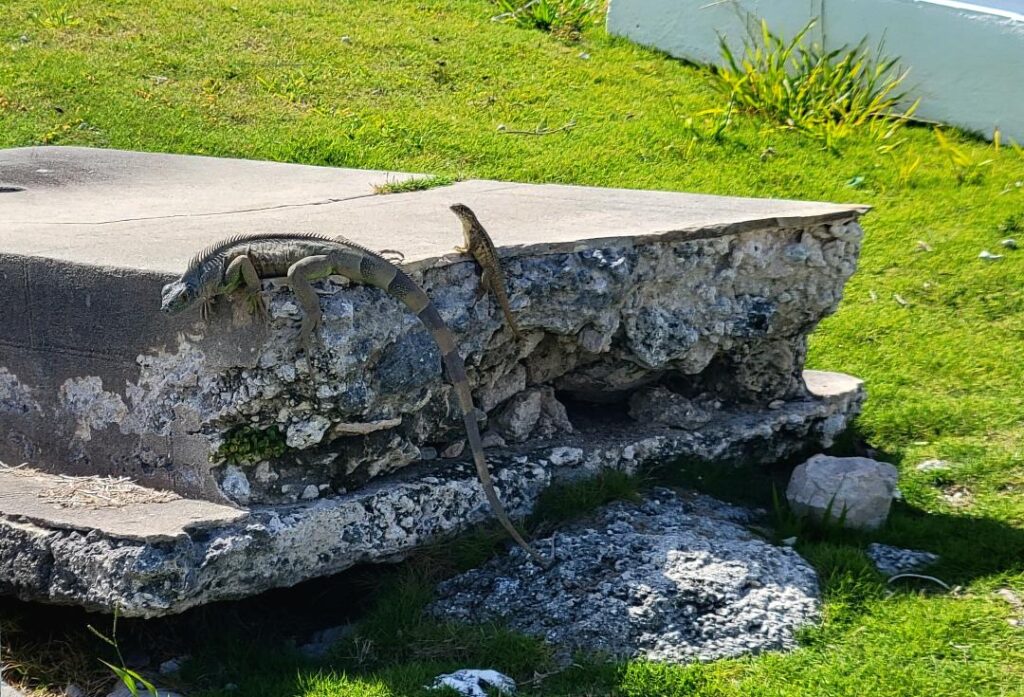
The iguanas looked like dragons from the European knight stories. Their bodies were covered with camouflage-colored scales, they had sharp claws and keenly active aware eyes. They looked old and worn like the grave stones that they rested upon. These beings did not resemble the fresh bright green iguanas that jump into water when a human disturbs their sunning routine. The cemetery stoic statues rested on the crypts but became strikingly quick and nimble when an intruder like myself came close. They scampered into holes between the ground and the tomb stones, right where a coffin should be.

They likely crawled into a coffin and rested comfortably in the ceremonial garments that the corpse was dressed in. They nestled next to dried up pieces of flesh and human bones. What a perfect place for the iguanas to nest, to create burrows in the sand between the cracks of stone crypts, to dig tunnels interconnecting the burrows. There must exist a whole underground network, a labyrinth between human remains. Female iguanas moving bones aside to make a cozy place where they can lay their eggs and where baby iguanas hatch.
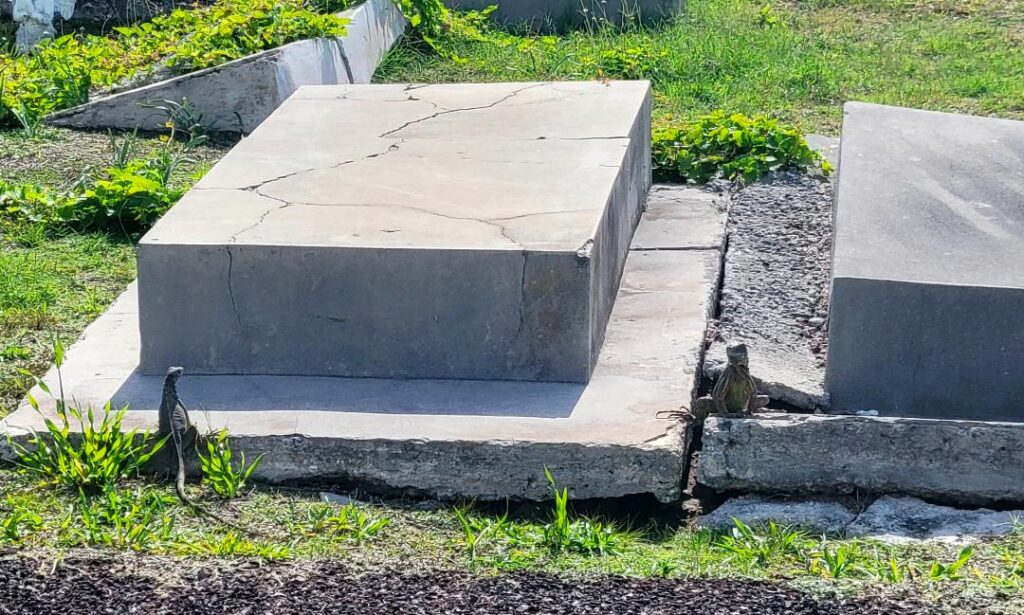
Iguanas are comfortable with their surroundings and they do not discriminate. Unlike people, who fenced off separate areas in the cemetery making sure dead Protestants do not mingle with dead Catholics, and the dead Jews are separate from the other two. Iguanas are all inclusive, they happily lay eggs in a Catholic grave or sunbathe on a Protestant crypt or between rocks carefully stacked upon a Jewish grave. What iguanas are not comfortable with are live humans disturbing the peace of a happy iguana land by stomping around and throwing shade onto sun-warmed stones.
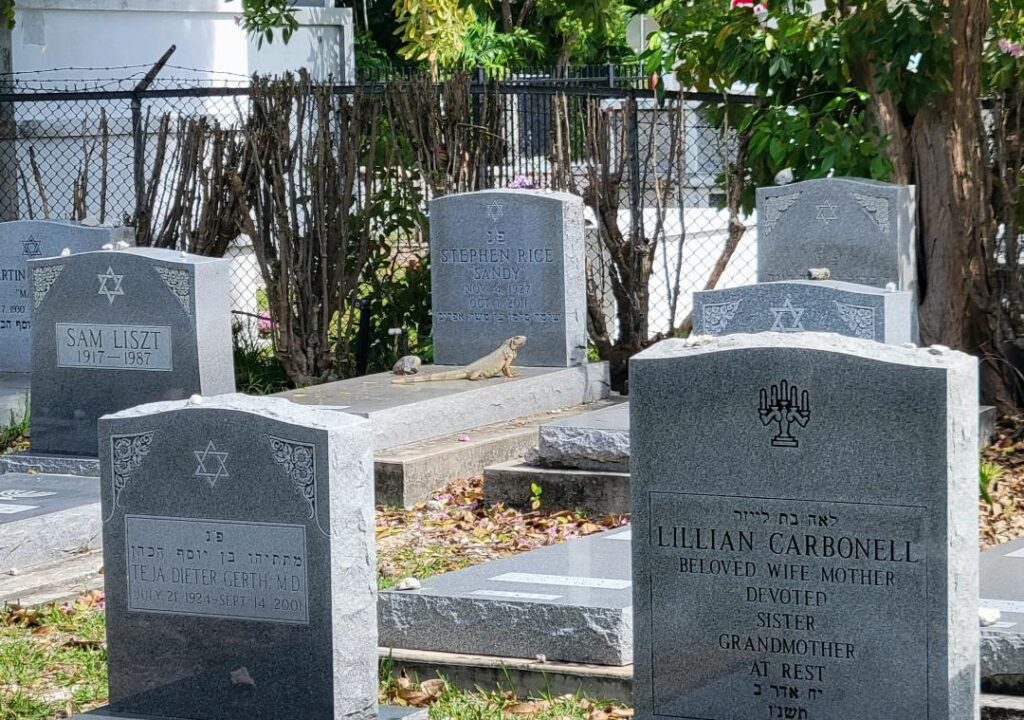
I could sense a conflict between me, a human, and the iguanas, the dominant cemetery residents. I felt entitled to the grounds and wanted to demand respect for my human dead. I did not like the gruesome feelings that I experienced when observing the iguanas scurrying into the graves and envisioning the macabre within. Similarly, the iguanas were visibly disturbed by my presence in their domain. They moved into the area in masses and they established their social system, an iguana neighborhood in the middle of bustling Key West. Their neighborhood has social structures with territorial divisions between the males. They maintain elaborate courtship rules. The courtship results in a new generation of little green beings which with time turn into dusty, muddy, orange creatures and become live gargoyles that sit on graves and soak up the Key West sunshine.
Looking around, it became apparent this was the iguana neighborhood and while I was allowed to visit the time has come for me to depart and go join the living people, on Duval Street.
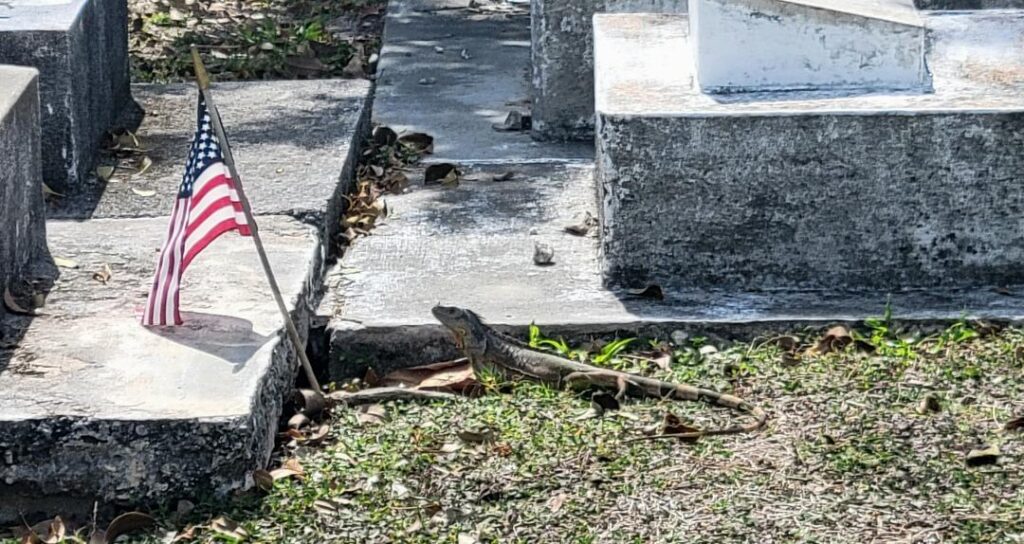
Patriotic Iguana – America!



Well that’s a well written fun story. I really like it.
mmmm… your new name… Irena Tlallen Poe…
We, too, like to find the cemeteries in the different places we have visited. They are usually interesting and have a certain aura of being surrounded by those that have gone before us. I could not express it as well as you have, though ! You are certainly a “writer ” !
Thank you. I was trying to create a morbid feeling in this piece ala Edgar Allan Poe, playing with the contrast between sunny, happy Key West and what might be going on below at the cemetery grounds. The concept was simple to come up with but not so simple to describe in the way I wished.